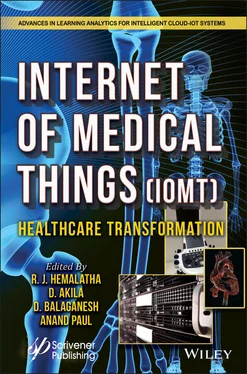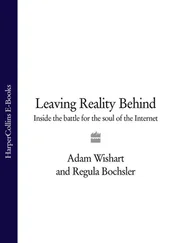12 Chapter 15Figure 15.1 Evolution of EHR.
1 Chapter 1Table 1.1 Physiochemical characters of EGFR, K-ras, and TP53 proteins as determi...Table 1.2 The number disulfide bonds were quantitated by Cys_Rec prediction prog...Table 1.3 Secondary structure of the EGFR, K-ras oncogene protein, and TP53.Table 1.4 Composition of α-helix EGFR, K-ras oncogene protein, and TP53.Table 1.5 Validation of the EGFR, K-ras oncogene protein, and TP53.Table 1.6 Predicted active sites of the EGFR, K-ras oncogene protein, and TP53.Table 1.7 Docking result of the EGFR, K-ras oncogene protein, and TP53.
2 Chapter 3Table 3.1 Type 1 VMM Approach.Table 3.2 Type 2 VMM Approach.
3 Chapter 4Table 4.1 Various symptoms of brain tumors.Table 4.2 Sample images used for classification purpose.Table 4.3 Performance of AlexNet pre-trained network.Table 4.4 Performance of GoogleNet pre-trained network.Table 4.5 Performance of ResNet101 pre-trained network.Table 4.6 Comparison of performance metrics between AlexNet, GoogleNet, and ResN...Table 4.7 Evaluation of accuracy and processing time of pre-trained network s .
4 Chapter 6Table 6.1 Applications of deep learning networks.
5 Chapter 10Table 10.1 Blood glucose classification.Table 10.2 Blood pressure classification.Table 10.3 Symptoms and signs of diabetic types.Table 10.4 DE parameter settings.
1 Cover
2 Table of Contents
3 Title Page
4 Copyright
5 Preface
6 Begin Reading
7 Index
8 End User License Agreement
1 v
2 ii
3 iii
4 iv
5 xv
6 xvi
7 xvii
8 xviii
9 xix
10 1
11 2
12 3
13 4
14 5
15 6
16 7
17 8
18 9
19 10
20 11
21 12
22 13
23 14
24 15
25 16
26 17
27 18
28 19
29 20
30 21
31 23
32 24
33 25
34 26
35 27
36 28
37 29
38 30
39 31
40 32
41 33
42 34
43 35
44 36
45 37
46 38
47 39
48 40
49 41
50 42
51 43
52 44
53 45
54 46
55 47
56 48
57 49
58 50
59 51
60 52
61 53
62 54
63 55
64 56
65 57
66 58
67 59
68 60
69 61
70 62
71 63
72 64
73 65
74 66
75 67
76 68
77 69
78 70
79 71
80 72
81 73
82 74
83 75
84 76
85 77
86 78
87 79
88 80
89 81
90 82
91 83
92 84
93 85
94 86
95 87
96 88
97 89
98 90
99 91
100 92
101 93
102 94
103 95
104 96
105 97
106 98
107 99
108 100
109 101
110 102
111 103
112 104
113 105
114 106
115 107
116 108
117 109
118 110
119 111
120 112
121 113
122 114
123 115
124 116
125 117
126 118
127 119
128 121
129 122
130 123
131 124
132 125
133 126
134 127
135 128
136 129
137 130
138 131
139 132
140 133
141 134
142 135
143 136
144 137
145 138
146 139
147 140
148 141
149 142
150 143
151 144
152 145
153 146
154 147
155 148
156 149
157 150
158 151
159 152
160 153
161 154
162 155
163 156
164 157
165 158
166 159
167 160
168 161
169 162
170 163
171 164
172 165
173 166
174 167
175 168
176 169
177 170
178 171
179 172
180 173
181 174
182 175
183 176
184 177
185 178
186 179
187 180
188 181
189 182
190 183
191 184
192 185
193 186
194 187
195 188
196 189
197 190
198 191
199 192
200 193
201 194
202 195
203 196
204 197
205 198
206 199
207 200
208 201
209 202
210 203
211 204
212 205
213 207
214 208
215 209
216 210
217 211
218 212
219 213
220 214
221 215
222 216
223 217
224 218
225 219
226 220
227 221
228 222
229 223
230 225
231 226
232 227
233 228
234 229
235 230
236 231
237 232
238 233
239 234
240 235
241 236
242 237
243 238
244 239
245 240
246 241
247 242
248 243
249 244
250 245
251 246
252 247
253 248
254 249
255 250
256 251
257 252
258 253
259 254
260 255
261 256
262 257
263 258
264 259
265 260
266 261
267 262
268 263
269 264
270 265
271 266
272 267
273 269
274 270
275 271
276 272
277 273
278 274
279 275
280 276
281 277
282 278
283 279
284 280
285 281
286 282
287 283
288 284
289 285
290 286
291 287
292 288
293 289
294 290
295 291
296 292
297 293
298 294
299 295
300 296
301 297
302 298
303 299
304 300
305 301
306 302
307 303
308 304
309 305
310 306
311 307
312 308
313 309
Scrivener Publishing100 Cummings Center, Suite 541J Beverly, MA 01915-6106
Advances in Learning Analytics for Intelligent Cloud-IoT Systems
Series Editors: Dr. Souvik Pal and Dr. Dac-Nhuong Le
Scope: The role of adaptation, learning analytics, computational Intelligence, and data analytics in the field of Cloud-IoT Systems is becoming increasingly essential and intertwined. The capability of an intelligent system depends on various self-decision making algorithms in IoT Devices. IoT based smart systems generate a large amount of data (big data) that cannot be processed by traditional data processing algorithms and applications. Hence, this book series involves different computational methods incorporated within the system with the help of Analytics Reasoning and Sense-making in Big Data, which is centered in the Cloud and IoT-enabled environments.
The series seeks volumes that are empirical studies, theoretical and numerical analysis, and novel research findings. The series encourages cross-fertilization of highlighting research and knowledge of Data Analytics, Machine Learning, Data Science, and IoT sustainable developments.
Please send proposals to:
Dr. Souvik Pal
Department of Computer Science and Engineering
Global Institute of Management and Technology
Krishna Nagar
West Bengal, India
souvikpal22@gmail.com
Dr. Dac-Nhuong Le
Faculty of Information Technology, Haiphong University, Haiphong, Vietnam
huongld@hus.edu.vn
Publishers at Scrivener
Martin Scrivener ( martin@scrivenerpublishing.com) Phillip Carmical ( pcarmical@scrivenerpublishing.com)
The Internet of Medical Things (IoMT)
Healthcare Transformation
Edited by
R.J. Hemalatha
D. Akila
D. Balaganesh
and
Anand Paul

This edition first published 2022 by John Wiley & Sons, Inc., 111 River Street, Hoboken, NJ 07030, USA and Scrivener Publishing LLC, 100 Cummings Center, Suite 541J, Beverly, MA 01915, USA © 2022 Scrivener Publishing LLC
Читать дальше













